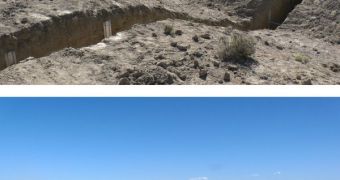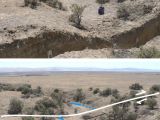Recently, scientists at the Arizona State University (ASU) and the University of California in Irvine (UCI) conducted a new research on the San Andreas fault line, but this time at the site of the giant earthquake of Fort Tejon (1857). The investigators analyzed data on stream channel offsets in the region, and were able to collect a wealth of pieces of information about the possible threats of earthquakes in the region for the near future. The work was conducted at the Carrizo Plain, which is located about 100 miles North of Los Angeles, California.
“These research results challenge the widely accepted characteristic earthquake model and could transform our understanding of fault behavior. The results show a substantially reduced estimate of time between large earthquakes on the south-central San Andreas Fault, which implies more frequent smaller earthquakes than previously believed. This in turn has significant implications for earthquake hazards in southern California,” scientist David Fountain, who is the program director of the National Science Foundation's (NSF) Division of Earth Sciences, explains. The DES funded this research.
The investigators applied a research methodology that was characteristic of systems science for this investigation. The full results of their analysis appear in the January 21 issue of the esteemed journal Science Express. In addition to the information the research team collected on site all on its own, the study also incorporates some of the best available data of the entire region. Ramon Arrowsmith and Olaf Zielke, both geologists at ASU, even used LiDAR (Light Detection and Ranging) technologies to measure the amount of fault movement, or offset, at the Carrizo Plain.
“When we combine our offset measurements with estimates of the ages of these offset features, and the ages of prior earthquakes, we find that the earthquake offset from event to event in the Carrizo Plain is not constant, as is current thinking,” Arrowsmith reveals. “The idea of slips repeating in characteristic ways along the San Andreas Fault is very appealing, because if you can figure that out, you are on your way to forecasting earthquakes with some reasonable confidence. Our results show that we don't understand the San Andreas fault as well as we thought we did. We therefore don't know the chances of earthquakes as well as we though,” Lisa Grant Ludwig, the leader of the UCI team at the research site, adds.
The work also seems to suggest that the San Andreas fault, one of the most dangerous in the American west, is not as segmented in its distribution of stress as researchers first thought. This implies that sections will not behave in the same way during each earthquake, thus making scientific predictions as to when the next major one may hit even more difficult. In addition, it would now appear that this fault line experiences a lot more tremors than seismologists and geologists first hypothesized, but that their intensity is a lot smaller. In the conclusion of their paper, the researchers write that they were able to identify about five meters of potential slip, which are ready to be released during the next large tremor.
“Our collaboration has produced important information about how the San Andreas Fault works. I am optimistic that these results, which change how we think about how faults work, are moving us to a better understanding of the complexity of the earthquake process,” Arrowsmith says. “The recent earthquake in Haiti is a reminder that a destructive earthquake can strike without warning. One thing that hasn't changed is the importance of preparedness and earthquake resistant infrastructure in seismically active areas around the globe,” Ludwig concludes.

 14 DAY TRIAL //
14 DAY TRIAL // 
